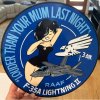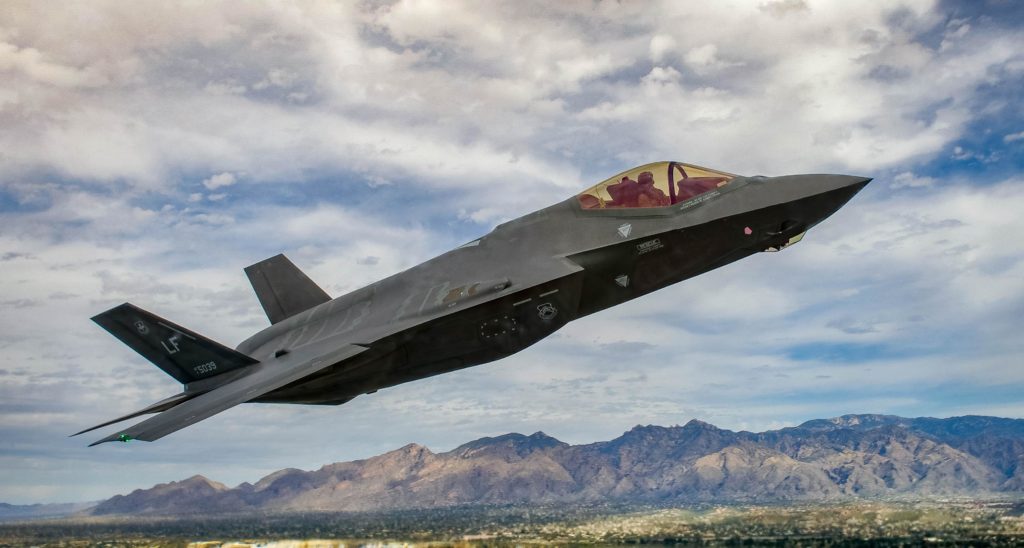F-35 Lightning II: A 21st century concept
Posted on December 2, 2019 by Alan Stephenson
The F-35 Lightning II is not only a fifth-generation fighter aircraft, but a 21st century tooth-to-tail concept. I recently had the privilege to join a Canadian media trip sponsored by Lockheed Martin to visit the F-35 production facility in Fort Worth, Texas, as well as the 63rd Fighter Squadron, at Luke Air Force Base, Ariz., which is responsible for F-35 pilot training.
Industry executives and F-35 operators presented detailed briefings on the latest aircraft improvements, maintenance concepts and operational considerations, as well as a tour of the production line and an up-close look at the aircraft itself.
Without a doubt, the F-35 system represents a progressive leap in technology and life cycle management.
Design concept
Although some have questioned the very idea of a “fifth-generation” designation, the F-35 is the result of an evolutionary process in the design of low-observable (stealth) fighter aircraft for the United States Air Force (USAF). It draws upon the experiences of creating and operating the F-117 Nighthawk and the F-22 Raptor fighters.
The lessons learned went beyond simply enhancing aircraft performance; the F-35 ameliorates fundamental life cycle cost issues through leveraging emerging technologies and leading-edge concepts to maximize readiness, logistic and maintenance efficiencies. In effect, the F-35 is built for sustainment.
The fighter aircraft makes use of a modular avionics architecture with fusion technology, rather than a federated architecture where Line Replaceable Units (LRU or “black boxes”) are placed in a sequence. In this manner, maintainers no longer need to remove the first and second boxes to replace the third; they simply replace an easily accessible modular LRU.
Roughly
95 per cent of the LRUs are first line removeable and virtually all first line maintenance functions are accessible through the weapons bay doors, nose wheel well, and behind panels that can be opened and closed without causing any low observable skin repairs. Ease of maintenance is further achieved from simple redesigns such as a front-hinged canopy that facilitates ejection seat removal without the need to remove the canopy.
ALIS, the state-of-the-art Autonomic Logistics Information System, provides real-time digital information that also significantly reduces maintenance demands.
“ALIS integrates a broad range of capabilities including operations, maintenance, prognostics, supply chain, customer support services, training and technical data,” according to Lockheed Martin.
Maintenance staff can quickly determine the health of the aircraft upon landing through Prognostic Health Management (PHM) and quickly resolve any anomalies, increasing the serviceability rate and minimizing technician fault-finding time through fewer maintenance steps. PHM is a maintenance system that monitors the actual condition of an aircraft to decide what maintenance needs to be done.
As all aircraft fleet operators know, unscheduled maintenance and lack of spare parts increases manpower demands and decreases aircraft availability. ALIS is designed to reduce maintenance hours, increase readiness, and decrease labour related costs by offering greater control in sustainment functions and providing actionable information to military decision-makers.
- Design features such as internal weapons carriage and pneumatic weapons ejection have reduced maintenance personnel hours. The F-35 clocks in at a reported six hours of maintenance per flight hour. USAF Photo
Cost drivers
From an initial reported cost of over US$100 million, the per-unit costs for the F-35 have fallen to US$77.9 million for Lot 14 fighters. The nine-nation co-operative development and the economies of scale of 12 current customers have greatly contributed to bringing life cycle costs closer to those of contemporary fourth-generation fighters.
Costs have been lowered in assembly of the aircraft through use of an automated production line, designed to produce 180 aircraft per year, which has seen a 75 per cent reduction in “touch-labour” since 2010. Each aircraft is personalized by purchase order, allowing all three models to be produced in tandem, and unlike other fighters, the jet is essentially combat-ready when it leaves the production facility, having complete indigenous offensive and defensive avionic suites.
With respect to sustainment, the
F-16 had 24 different stovepipes supporting worldwide operations. ALIS logistics functions are networked with all F-35 users and supports a consolidated global supply chain that aggressively sources and produces the most cost-effective parts available, making them available as required and thereby minimizing costly inventory. A mandated Reliability and Maintainability (R&M) program has established metrics within automated processes designed to ensure constant systemic evaluation and facilitate continuous improvements that lower support costs and expedite fleet upgrades.
At a reported six hours of maintenance per flight hour, the F-35A is at the forefront of fighter operations. Conscious design features such as internal weapons carriage and the use of pneumatic (air pressure) weapons ejection rather than explosive cartridges has significantly reduced maintenance personnel hours required to clean and service fourth generation weapons delivery systems.
Another
example of manpower savings occurs in routine checks on the fuel tanks and valves, where only one F-35 technician with a Portable Maintenance Aide (a laptop computer the technician connects to the F-35) is now required to conduct the same task that requires six maintainers to perform on the F-16. In manpower savings alone, anecdotal evidence suggests a 60 per cent reduction in personnel to perform routine maintenance functions.
Operations
At the flight line, significant changes have occurred to USAF military occupations and employment through innovative maintenance developments such as the Blended Operational Lightning Technician (BOLT) and the Lightning Integrated Technicians (LIT) programs.
The BOLT program combines six USAF technical trades into two streams. The Air Vehicle stream includes crew chiefs, fuels, and low observable technicians, while the Mission Systems stream focuses on avionics, weapons, and egress trades. This streaming not only economizes manpower but allows deployed operations to be conducted with a smaller personnel footprint. In addition, the LIT program was introduced to increase maintenance efficiencies and effectiveness by integrating these two streams into one co-ordinated team through establishing commonality in training and dedicating each team to a single aircraft.
The low observability of the F-35 is more than just a means to penetrate adversary defences; it is a “nose-to-tail” concept that increases performance and survivability from reduced drag and a low platform electromagnetic signature.
The embedded antennas in the radar absorbent skin, internal fuel tanks and weapons carriage, and full line-of-sight radar reflection blockage not only help define the F-35 as a fifth-generation fighter, but the addition of an advanced sensor suite with sensor fusion, an electro-optical Distributed Aperture System (DAS) electronic warfare suite and networked enabled operations cement the fifth-generation classification.
The Active Electronically Scanned Array (AESA) radar is a computer-controlled array antenna in which individual radar beams can be electronically steered to point in different directions without moving the antenna. This feature allows the F-35 to perform multiple functions such as detecting, tracking, and attacking airborne targets while simultaneously countering or attacking ground-based radar systems. When combined with the embedded sensors and advanced CNI (communications, navigation, identification) capabilities, the
F-35 becomes an ISR (intelligence, surveillance, reconnaissance) as well as a command and control (C2) platform. These radical innovations elevate the F-35 from a tactical fighter to an operational asset with strategic value.
The F-35, with commonality shared amongst its three variants, can perform air-to-air, air-to-surface, electronic attack, ISR gathering, and localized C2 roles during a single mission. Tactically, the increase in situational awareness allows F-35 pilots to fly farther apart and with more individual freedom, changing the manner in which fourth-generation fighters are employed. Operationally, a flight of F-35s flying missions in the Arctic can also provide localized ISR and C2 functions in a region devoid of such assets.
Additionally, the F-35 requires fewer operational support platforms such as AWACS, Joint STARS and stand-off electronic warfare aircraft to conduct combat operations.
The F-35 could be considered a strategic asset that would allow Canada to offer NATO the flexibility of employing Canada’s fighter commitment strategically to support either the traditional northern flank or send its assets to central Europe. In either case, eight NATO nations will already have their own F-35 infrastructure in place to operationally facilitate Canadian integration.
Conclusion
Given the innovative design, leading-edge avionics suites, automated production line, networked sustainment program, globalized supply chain, and fundamental changes to how air forces conduct business, it is hard to argue that the F-35 is not only a fifth-generation fighter, but that the F-35 system is a transformational 21st century concept.
The F-35 is more than a simple multi-role fighter, it is multi-mission platform. There are indeed identified problems as the F-35 program matures that are part of the evolution of any new platform. However, with the weight of the U.S. government and 12 customer nations, the chances are that these challenges will be resolved satisfactorily.
With the cost to own an F-35 fighter in the same range as other fighter aircraft on the market today, the real discriminators are in the costs to operate and the value-added to military operations.
Alan Stephenson (Col ret’d) holds a PhD from Carleton University and is a former CF-188 pilot with 3,600 hours flying fighters. He is currently an aviation consultant and a Fellow at the Canadian Global Affairs Institute.
A media visit sheds some light on the F-35 fighter jet's design, production and processes.

www.skiesmag.com








